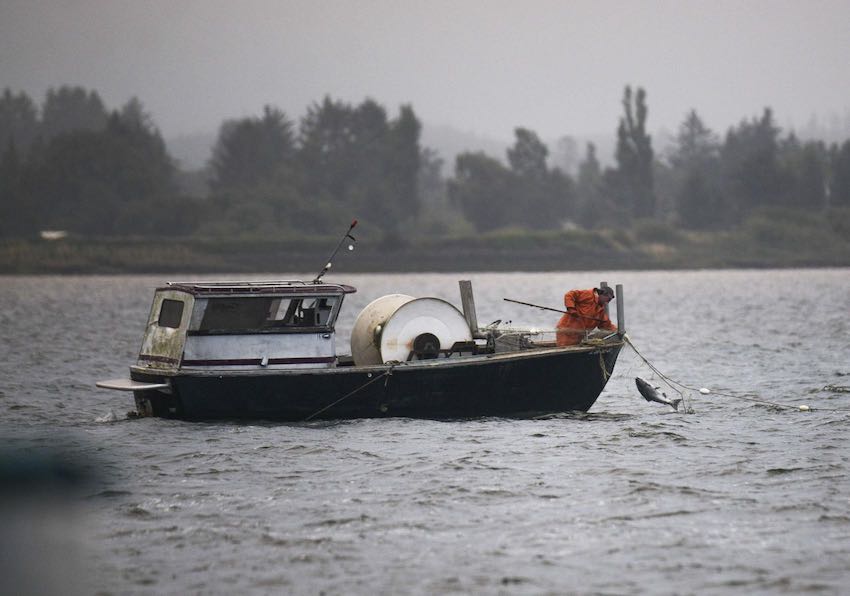forum
library
tutorial
contact

States Set Lower Columbia River
Mainstem Commercial Gillnet Fishing
by Columbia Basin Bulletin
Chinook Observer, August 15, 2019
|
the film forum library tutorial contact |

|
States Set Lower Columbia River
by Columbia Basin Bulletin
|
Non-treaty gillnetters get 45 hours through Aug. 29
 COLUMBIA RIVER -- With less than half of the 10-year average of fall Chinook salmon expected to return to the Columbia River this year, the two-state Columbia River Compact opened commercial gillnetting in the lower river and in pools upstream of Bonneville Dam for treaty commercial gillnetting.
COLUMBIA RIVER -- With less than half of the 10-year average of fall Chinook salmon expected to return to the Columbia River this year, the two-state Columbia River Compact opened commercial gillnetting in the lower river and in pools upstream of Bonneville Dam for treaty commercial gillnetting.
Some 349,700 fall Chinook are forecast by the U.S. v Oregon Technical Advisory Committee to enter the Columbia River this year, with 228,600 expected upstream of Bonneville Dam (passage at the dam is typically half complete by Sept. 9). The anticipated return this year is higher than 2018, when actual returns totaled 293,424 fish, but is just 47 percent of the 2009-18 10-year average of 737,720 fish.
As of Aug. 14, the count of fall Chinook passing the dam is 6,474 adults (67 percent of the 10-year average of 9,678 for that date) and 1,201 jacks (67 percent of the 10-year average of 1,787 jacks).
The Compact met this week, Monday, Aug. 12, at the Washington Department of Fish and Wildlife's regional office in Ridgefield to consider early fall Chinook mainstem gillnetting, deciding on 5 nine-hour overnight periods, for a 45-hour total for commercial non-treaty gillnetters beginning Aug. 14 and ending Aug. 29.
The states also approved treaty commercial fall Chinook gillnet fishing. Some 2.5 days are allowed in each of two openings beginning 6 a.m. Aug. 26 to 6 p.m. Aug. 28, and 6 a.m., Sept. 2 to 6 p.m. Sept. 5., all in Zone 6 (Bonneville, The Dalles and John Day pools). The Compact in its Fall Fact Sheet No. 3 says it is taking a "conservative approach to managing 2019 fall fisheries." The tribes expect to take 25,200 fall Chinook during this period with 13,100 of those fish being upriver brights. They also expect to take 2,090 steelhead, including 180 of the larger B-run steelhead destined for the Snake River, and 945 coho salmon.
Dave Moscowitz, executive director of The Conservation Angler, said his group appreciates this conservative approach taken by the Compact and Tribes in approaching commercial fishing season approvals, but he also called out some concerns, not the least is a lack of confidence in forecasts and a lack of spawning escapement information when setting fishing periods.
"Given the low forecasts, the inability to provide detailed stock status updates and the failure to deploy a robust and all-encompassing monitoring and observation protocol across all fisheries, The Conservation Angler believes that while the fishery approach is conservative, the likelihood of over-harvesting or impacting critically low numbers of returning ESA-listed salmon and steelhead stocks remains real," Moscowitz said.
The fall Chinook run is composed of seven management components, according to the Compact's Fact Sheet. They are:
Lower River Hatchery (LRH),
Lower River Wild (LRW),
Bonneville Pool Hatchery (BPH),
Upriver Bright (URB),
Pool Upriver Bright (PUB),
Lower River Bright (LRB).
A more positive aspect of this year's fish runs is the anticipated return of coho salmon of 611,300 adults, which includes 388,000 early stock and 223,300 late stock. That is 162 percent of the recent 10-year average of 377,900 fish. Coho over Bonneville Dam is expected to reach 180,300 fish, which represents 64 percent of the forecast ocean abundance of Columbia River coho destined for areas upstream of Bonneville Dam, the Fact Sheet says. Some 37 adults and 20 jack coho have been counted at Bonneville Dam through Aug. 14, about the same number passing by this date last year, but lower than the 10-year average.
Related Sites:
Fish Traps, Alternative To Current Commercial Fishing Methods, Being Tested In Lower Columbia Columbia Basin Bulletin, 12/15/17
ODFW Reopens Harvest Rules Focused On Phasing Out Mainstem Gillnets Below Bonneville Columbia Basin Bulletin, 12/15/17
Oregon Harvest Reforms Differ From Washington In How Much Gillnetting Allowed Columbia Basin Bulletin, 1/27/17
Washington Votes To Move Forward With Columbia River Harvest Changes, Oregon To Consider Similar Plan Columbia Basin Bulletin, 1/27/17
Washington, Oregon Fish/Wildlife Commissions On Parallel Course With Columbia River Harvest Reform Columbia Basin Bulletin, 12/9/16
Washington, Oregon Fish/Wildlife Commissions Considering Next Moves On Lower River GillnettingColumbia Basin Bulletin, 12/2/16
Oregon Commission To Review Columbia River Harvest Reforms, May Consider Extending Mainstem Gillnets Columbia Basin Bulletin, 11/4/16
Oregon Commission Hears Review Of Fishing Reforms Banning Lower Columbia Gillnetters From Mainstem Columbia Basin Bulletin, 4/22/16
Oregon ‘Re-Adopts' Lower Columbia Commercial Gill-Net Ban; Slew Of Uncertainties Remain Columbia Basin Bulletin, 6/7/13
Related Pages:
Don't Support Gillnetting by Vince Archibald, The Daily Astorian, 3/7/19
Preliminary Data Shows Steelhead Mortality from Gillnetting May be Lower than Thought by Staff, Columbia Basin Bulletin, 1/26/18
learn more on topics covered in the film
see the video
read the script
learn the songs
discussion forum
